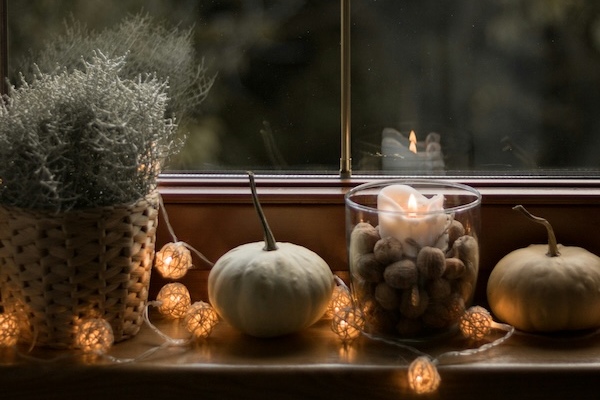
Fall has officially arrived, and it’s the perfect time to transform your home into a cozy, seasonal retreat! But before you start adding those autumnal touches, it’s important to consider the impact of our decorating habits. Too often, we buy more and throw away what no longer fits the season, contributing to unnecessary waste.
This year, why not take a different approach? We’ve put together a collection of sustainable decor ideas that not only help reduce your carbon footprint but also create a warm and inviting atmosphere in your home.
Plus, going green often means saving some green, too—many of these tips can help you save money as you decorate!
By embracing a conscious consumer mindset, you can make your home an autumn haven while staying kind to the planet. Let’s get started!
Extra Tips for Your Sustainable Fall Ahead!
Check out these handy resources to help you become a more conscious consumer and make smart, eco-friendly choices this fall!
Skip Disposable Decorations
When it comes to fall decorating, one of the easiest ways to make a sustainable impact is by skipping disposable decorations. It’s tempting to grab those themed plates, cups, napkins, and utensils, but they’re often used for just a few hours before being tossed in the trash.
Instead, opt for reusable alternatives that reduce waste while adding a touch of elegance to your gatherings. Think cloth napkins, ceramic dishes, and metal utensils—items you can enjoy year after year.
Plastic decor like confetti, party poppers, noise makers, and streamers may seem fun, but they’re neither reusable nor recyclable. These items quickly find their way to landfills, contributing to environmental harm. If you must use disposable supplies, choose compostable options that break down naturally and return to the earth without leaving a trace.
Embrace Edible and Compostable Decor
For a sustainable and charming fall look, embrace edible and compostable decor. Start by incorporating natural materials like pumpkins, gourds, dried flowers, and elements from your own yard—think leaves, pinecones, acorns, and branches.
These items are perfect for DIY decorations, adding a personal touch while minimizing your environmental impact!
When selecting pumpkins, go for the edible ones. After the season, these pumpkins can double as ingredients in your favorite recipes, and any leftover pumpkins can be composted to reduce waste. Remember, pumpkins aren’t just pretty—they’re packed with vitamins C and E, potassium, and antioxidants.
Edible accents like apples, cinnamon sticks, and nuts can also enhance your sustainable decor. These items can be enjoyed as part of your seasonal snacks or composted once their decorative purpose is served. By choosing natural materials that decompose harmlessly, you’re reducing waste while creating a warm and inviting autumn atmosphere.
Rent, Borrow, or Shop Secondhand
To make your fall decorating both sustainable and stylish, consider renting, borrowing, or shopping secondhand. Instead of purchasing new items that might only see the light of day once a year, borrow decorations from friends or rent them from local shops. It’s a simple way to refresh your space without contributing to waste.
When you do need to shop, head to thrift stores, charity shops, or secondhand markets. These places are treasure troves of unique, gently used seasonal decor that’s not only budget-friendly but also eco-friendly. Prioritize finding durable items made from materials like ceramic, glass, or fabric—pieces that are built to last and can be enjoyed for many seasons to come.
By shopping secondhand, you’re supporting local businesses and reducing the demand for mass-produced, resource-heavy products, making your decorating choices as kind to the planet as they are to your wallet.
Get Creative with Upcycling
Upcycling is the art of transforming waste materials or unwanted items into new, high-quality decor that carries both artistic and environmental value. Instead of tossing out old items, give them a second life as unique fall decorations. For example, turn those empty mason jars into charming candle holders.
There’s no shortage of DIY projects to explore. These projects are often simple, cost-effective, and offer a fantastic way to tap into your creative side while reducing waste. Upcycling not only saves money but also keeps materials out of landfills, making it a budget-friendly and eco-conscious choice.
If you’re in need of extra supplies, check out local thrift shops or secondhand stores. These places are full of items just waiting to be reused and repurposed, ensuring your upcycling projects are both sustainable and resourceful.
Opt for Energy-Efficient Outdoor Lighting and Heating
When it comes to lighting up your fall evenings, opt for LED lights instead of traditional incandescent bulbs. LEDs are far more energy-efficient, have a longer lifespan, and make for a more sustainable choice, both indoors and outdoors.
For outdoor areas like patios, consider solar-powered lights. These charge during the day using sunlight and provide a gentle, eco-friendly glow at night, helping you cut down on energy consumption while lowering utility costs.
As temperatures drop, keep your outdoor areas comfortable with solar-powered patio heaters. Unlike traditional heaters that rely on fossil fuels, these heaters use renewable energy sources, allowing you to stay warm while being kind to the planet.
By choosing energy-efficient lighting and heating options, you’re reducing your carbon footprint while also embracing a more sustainable lifestyle. All this, while enhancing the beauty and comfort of your fall decor, makes for a win-win situation.
Compost and Donate Unwanted Decor
Don’t toss your natural fall decor! Consider composting materials like pumpkins, gourds, and leaves. These organic items break down into nutrient-rich humus, perfect for enriching your garden soil come spring.
Starting a compost pile with fallen leaves is also a simple and effective way to create valuable organic matter for your garden, all while reducing waste.
For decor items that are still in good condition but no longer needed, think about donating them to local charities, thrift shops, or community centers.
By choosing to compost and donate, you’re actively reducing the amount of waste that ends up in landfills, which in turn helps lower your carbon footprint and supports a circular economy. And if home composting isn’t an option, check out local composting programs where you can drop off organic materials for eco-friendly disposal.

